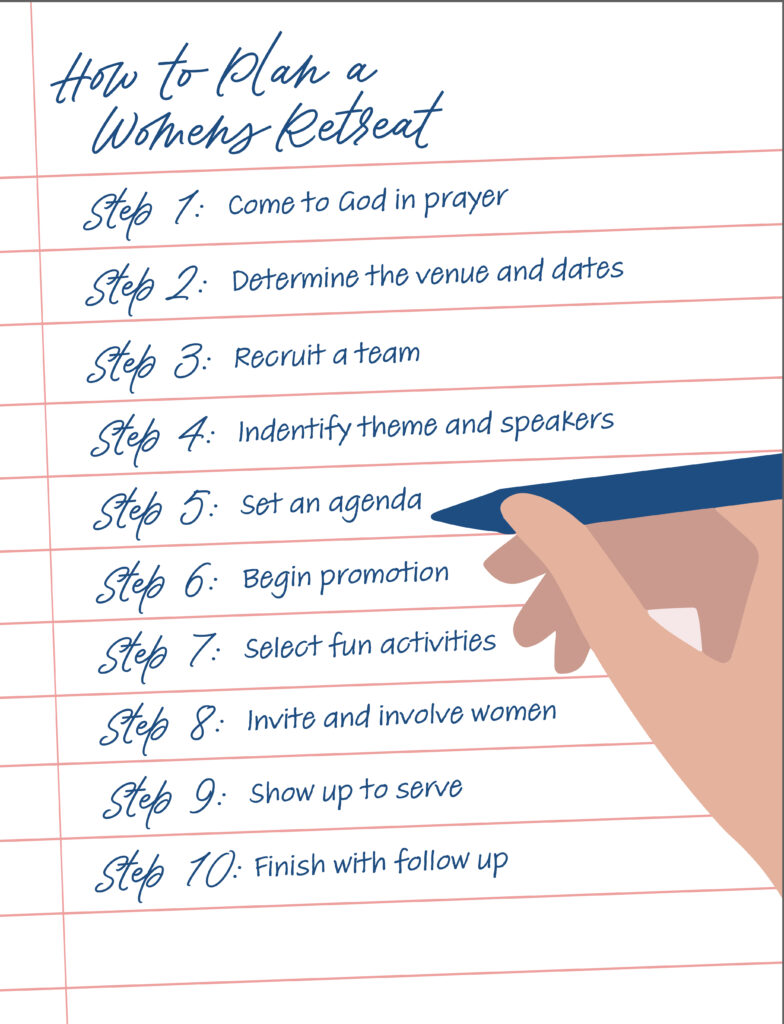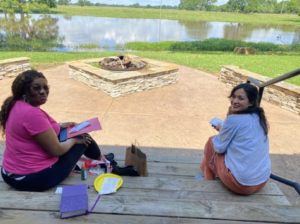A women’s retreat is time away from the daily grind to connect with God, oneself, and others. You may be tackling the task of planning your women’s church retreat. Maybe you’re coordinating a Christian retreat for a smaller community group or parachurch ministry.
If you are planning a women’s retreat, you likely have personally experienced the benefits of a retreat. Knowing how to organize a women’s retreat involves managing a lot of details. Before looking at a step-by-step guide to planning, refresh your memory on the purpose of a women’s retreat.
What is the purpose of a women’s retreat?
A women’s ministry retreat provides space for women to connect with God and one another. Like a sheltering umbrella, a retreat can offer women focused opportunities to connect vertically with God. This connection can happen through worship, hearing the Word of God, and personal reflection and prayer. A ladies’ retreat also provides sweet opportunities to connect horizontally with one another. Group discussion, fun games, outdoor activities, creative outlets, and organic conversation over meals are examples.
When women connect more deeply with God and others, they experience growth personally and as a community. Traci Martin, Director of Engagement at the Network of Evangelical Women in Ministry, shares, “I would summarize the benefits of a retreat as a time of being replenished by the Lord, refreshed in the Word, and reconnected with the body of Christ.”
Steps in Planning a Women’s Retreat
You’re excited to get started with planning the retreat. At the same time, do you feel overwhelmed? Maybe you’re not sure where to start or how to juggle the details. What should a retreat include anyway? Theme, content, location, delicious food – how can you pull it all together? Women’s ministry leaders and experienced retreat planners from across the country weighed in to answer with the following steps.

Step 1: Come to God in prayer.
Prayer is a means to know God better and partner with Him in the process of retreat planning. Start with asking his guidance in every decision and detail. Calling others to pray throughout the retreat planning is key. Christine King, who gives direction to the women’s ministry team at Trinity Presbyterian in Virginia, suggests, “Identify a team that is committed to praying regularly during the preparation.” Ask prayer partners to pray as they feel led over these areas:
- The Spirit’s work in the hearts of the women who attend through the theme, setting, and relationships
- Women’s faith to be increased as they use their gifts and skills in retreat planning and for unity among the team
- Favor, creativity, and wisdom for details, logistics, and speaker(s)
- Joy for all who participate and meaningful personal growth that lasts beyond the retreat
- Spiritual protection for all. Kari Stainback, who serves as Senior Director of Women’s Ministries at Park Cities Presbyterian in Dallas, Texas, offers this reminder: “Pray fervently, because Satan doesn’t like retreats.”
Step 2: Determine the venue and dates.
Decide how long the retreat will be and where you will hold it. This step may happen before or during the process of recruiting a team, so the team members may or may not be involved.
When considering retreat length, Kari Stainback offers helpful insight about a two-night retreat: “You really get to know your women when it is more than a one-night event. And they have more time for shared experiences together.”
Stainback also emphasizes the importance of sleeping options. “It is hard to sleep in a bunkhouse! Do all you can to make the sleeping experience good for your women. Comfort for women over 45 is key for them to attend.”
Additionally, Teresa Snow, who has served over 30 years as a women’s leader within Cru City, a ministry to business and professional women, comments about location: “I suggest looking for a location that is 1-2 hours’ drive. It provides the opportunity to be away and not too far of a drive.”


Step 3: Recruit a team.
Depending on the retreat size, it’s wise to recruit anywhere from one to several dozen women to serve alongside you as a team. Holly Crain, who served as Women’s Ministry Director to Single Parents and Young Adult Women at Houston’s First Baptist for 16 years, explains: “It takes a team no matter what the size of the retreat. It is always best to involve as many people as possible in the planning so those on the team can use their gifts.”
You will want to have your team in place before making important decisions about flow and logistics. On average, larger retreats take 6-12 months (or more) to plan; smaller ones can be planned in 3-6 months. Crain shares, “I have planned retreats in less than 6 months. If you have the time, use it, but don’t let time be a hindrance to moving forward where you believe the Lord is leading.”
Give your team members specific roles and responsibilities.
Create roles that serve the purpose of your unique retreat. These may include food planning, activities, communication, roommate assignments, and prayer. Courtney Garrett, who served as a Women’s Ministry Director for 8 years before founding 101 Christianity, offers input for larger retreats: “Ask someone to head up the retreat team who is not the women’s ministry leader, so this person can be solely focused on the team. Ideally you have a woman who works closely with the team leader so that she can step in next year.”
Meet together.
How often you meet depends on the length of your retreat planning. Garrett suggests gathering as a team once a month. A benefit of connecting in person is that the women can build friendships and pray together. Missy Edgmon, Women’s Minister at First Colony Church of Christ in Sugarland, Texas, offers another angle: “If you get one all-together meeting, that’s a win. Break up the jobs into smaller chunks and communicate with those subgroups. Keep them updated with concise emails that give updates and clear requests.”
Allow team members freedom to create.
Knowing that a leader can be over-involved in retreat details, Edgmon says, “When you delegate, let [team members] run with it and do the job. Guide as necessary.”
Pray for wisdom, creativity, and unity among team members. Cammie Howard, Minister to Women and Youth at Lake Forest Church in Huntersville, NC, shares her experience: “Make sure you have someone who is very detail-oriented who can help with finances and registration. I try to involve a good mix of ages. We also give half off registration to women who are on the team.”
Step 4: Identify Theme and Speakers.
Choosing the theme for your retreat is one of your most important decisions, so keep this step steeped in prayers for wisdom.
“Start by asking the Lord what he has for the women during the retreat,” says Traci Martin [Network of Evangelical Women in Ministry]. Then discuss these questions with your team as you seek the theme together:
- “What do we want the women to be saying about the retreat afterwards?”
- “What would make a successful retreat for us?”
- “What are the needs and challenges of these women?”
- “What is going on in the culture around us?”
Answering these questions will help you select a theme and Bible passages that go with it.
Another approach to choosing a theme is to secure your speaker first. Speakers outside your community may have built-in themes to choose from.
If your retreat team plans to enlist a speaker outside your church community, reach out to check her availability. You will also want to secure a person or group to play music and lead worship. Musicians may be volunteer or paid, depending on your budget.
Your best speakers and teachers may be closer than you think! Ask women in your community to use their teaching gifts to share content. Courtney Garrett recommends alternating years with speakers who are inside your community with those who are not.
Dr. Sandra Glahn, Professor of Media Arts & Worship at Dallas Theological Seminary, adds, “Use as much local talent as possible. This is the biggest chance most women leaders have within the church to help other women develop their teaching gifts.”
You can read more about how to choose a women’s retreat theme in Themes for Christian Women’s Retreats: Finding the Perfect Focus for Your Gathering.
Step 5: Set an Agenda.
What happens at a Christian women’s retreat? Setting a tentative agenda helps turn your vision for the retreat into practical realities. Successful retreat agendas balance time for spiritual growth and developing friendships, as well as balancing activities and free time. Based on the needs of your women’s ministry, you may choose to implement an agenda for a one-day, overnight, or weekend retreat. You’ll likely tweak your agenda during the planning process, but having a working plan helps the retreat take shape.
Choose an emcee.
An emcee is essential to keeping the agenda flowing at the retreat. Identify and ask a woman who is comfortable in front of an audience and who helps others feel relaxed. Humor is a big asset!
Once you’ve secured your emcee and speaker(s), keep the following principles in mind as you hammer out the agenda details.
Carve out time for connection.
One of the benefits of retreats is shared memories. Balance content with organic moments and fun activities. One way to do so is by carving out get-to-know-you times throughout the retreat.
One way to help women engage in intentional conversation: Divide women into groups of 5-8 and ask them to set a timer for 3 minutes. Each woman then chooses a question to answer about herself from a printed list of 10-15 questions. Those planning for this activity can find great questions from a resource such as 260 Best Questions.
Nancy Abbott, who served as a Women’s Ministry Director for two decades, suggests, “Use mealtime for engaging with [optional groups] who want to talk about certain things like singleness, motherhood, parenting adult kids, anxiety and depression.”
Many retreats include a Saturday afternoon. If possible, reserve free time between lunch and dinner. Schedule optional activities that women can participate in if they desire, such as exercise or sports outlets, creative projects, games, and pampering opportunities.
Women’s Minister Missy Edgmon explains, “Space time in between scheduled activities to allow women to visit organically, but not so long that loners get scared and bolt. I had one woman bolt, but she talked to me about it later, and I’m giving her a job this time.”
Plan for small group time or breakout sessions.
Women benefit from time spent in small groups to discuss what they are gaining from the content and how to apply it. Consider asking the session speaker to come up with group questions for further discussion of her topic. Courtney Garrett, founder of 101 Christianity, recommends using the backs of name tags to designate by color which group each woman will join. Garrett also recommends these groups meet 3 times during a 2-night retreat. Another way to group women is to pair them in 2s for intentional conversation. Laura Wilcox, Women’s Ministry Leader and Founder of Sacred Story Ministries, weighs in: “Women are given a timeframe during our story retreats to connect in 2s. I’ve seen God move in special ways each time as women begin to be vulnerable about their stories.”
Provide prayer opportunities.
Offering opportunities to pray may take the form of setting up a prayer room and creating time slots for women to be prayed over for specific needs. Retreat organizers can also offer copies of guided prayers. These can especially help a woman pray for friends, family, and neighbors who need to hear the good news of Christ’s love. By doing so, she will be reminded of the greatest privilege believers have—partnering with the Lord in seeking and saving the lost (Luke 19:10).
A well-thought-out agenda ensures time is spent in achieving the overall goals for the retreat. As the retreat planner, keep those overall goals in mind when you run into inevitable bumps along the way. See Examples of Women’s Retreat Agendas for specific guidance.
Step 6: Begin promotion.
Putting out the word about your retreat requires thought and planning. Christi Smith, Director of Women’s Ministry at Houston’s First Baptist Church, shares about her team’s process: “We make sure the communication is consistent and frequent. The younger the person, the shorter the lead time she needs for communication about an event. The older a person is, the longer the lead time she expects.”
“We usually put out a ‘save the date’ a number of months in advance and follow up with a short video which is 60 seconds or less,” explains Smith. “Then we may wait a while before the next communication. We also create an editorial calendar for how and what and when we communicate.”
Ways to Promote a Women’s Retreat
- Create a physical reminder: Design a bookmark featuring the theme of the retreat and a QR code linking to the registration page.
- Offer discounts: Communicate an incentive for early registration before a certain date.
- Publish a schedule: Be transparent about what will go on at the retreat, so women know what to expect.
- Share stories: Encourage a woman who has gone to the retreat in the past to share her experience through video or written form. (If she was initially hesitant but had a great experience, her story could be especially helpful!)
- Create retreat-themed merchandise: Consider how this year’s retreat will promote future ones. Design retreat-themed Scripture cards, bookmarks, journals, or t-shirts.
- Use digital communication: Think about your audience’s preferred media. Use multiple avenues—video, images on social media, emails, and printed cards.
Step 7: Select fun activities.
Activities for women’s retreats are designed to create connection and memories, which can lead to laughter, fun, and even tears. The time spent engaging in an activity adds to a sense of togetherness. As you’re choosing fun activities for a women’s retreat, keep these categories in mind:
Movement
Listening to content and being part of group discussions are meaningful and insightful. However, when being still and listening goes too long, it can be draining. Build in movement by providing exercise outlets like a group walk, pickleball tournament, Pilates class, or time at the pool or hot tub if available.
Competition
Friendly competition can be a fun way to bond. Board games and card games spur on team bonding. A scavenger hunt, mahjong lessons, or an escape room experience can also enhance a team mentality.
Creative Skills
Many women enjoy creating or learning a new skill. Maximize the gifts of women in your community by asking what kinds of projects they can help others do and what skills they can model. Can they watercolor, make jewelry, knit, or create a storyboard? Surprising talents are likely hidden in your group!
Step 8: Invite and involve women.
Personal invites make the most impact. Ask small group leaders to invite the women in their groups. Cammie Howard explains, “Individual asks, in the form of friend to friend, are helpful. When a woman is invited personally, she has someone to talk through the barriers. Also, promotion that involves women sharing about their past experiences is good, especially coming from a woman who was hesitant herself and then sharing what she received.”
Volunteers
As women register, keep in mind the need for volunteers beyond your retreat team. Many women feel more comfortable at an event when they have jobs to do. Common areas to serve include welcoming and registration, bringing food and helping with meals. During the group gatherings, volunteers may assist with technical needs, handing out supplies or assisting the speaker(s).
Step 9: Show up to serve.
Christi Smith has given direction to as many as 150 volunteers for a women’s conference with 1000 attendees at Houston’s First Baptist Church. She encourages a sacrificial mindset for volunteers.
“If you’re serving, your joy should be to serve,” says Smith. “Your expectations are different from those who are attending because you need to be aware of what’s going on. I’m not saying you’re not going to get things out of it, you absolutely will. Make sure you come filled up to pour out. We created team huddles for people serving to pray together beforehand and consecrate the space.”
Smith also shares, “I try to be present. I take in moments to turn around and look at the women in the audience. I also try not to be such a slave to the schedule that I miss everything. We also don’t stray too far off the schedule. If we fail to keep the timeframes, it affects the trust women have in our leadership.”
Build in small moments to take time to connect with the women who are attending through small gestures like saying hello, giving a hug, and offering to pray with a woman when needed. Encourage your team to do these things as well, and when possible, to engage in an activity.
Step 10: Finish with follow up.
Toward the end of the retreat, ask the women to fill out an evaluation with about 5-10 questions. Make filling out the evaluation easy. For example, include questions such as, “On a scale of 1-5 (1 being “just ok” and 5 being “couldn’t be better”) rate the following: schedule, food, accommodations, content/speaker, activities, value.” Leave space for overall comments at the end of the evaluation.
Google Forms is a user-friendly survey tool that can be easily distributed to retreat attendees.
You can provide an incentive by entering women who complete the survey in a drawing for a giveaway. Send the evaluation again by email about 3 days after the retreat to capture those who didn’t get a chance to fill it out during the retreat.
Depending on the goal of the retreat, think about what you can do afterwards to come alongside leaders. Smith encourages leaders to build in a “fourth trimester” as a way to think about follow up. You may choose to pair women up to debrief together, prepare a handout to work through, or send out a follow-up email with resources and options to connect.
Laura Wilcox comments, “We treat the retreat team to dinner out within a month after the retreat. We celebrate and share our thoughts on how the retreat went. We also build in follow-up editing after Sacred Story Retreats so that a woman can bring her story to completion.”
“The end game is what happens in women’s lives and how we can come alongside them after,” Smith says. Along with a debrief with other retreat leaders within a month after the event, Smith builds in the expectation that the follow-up in the lives of women after the retreat is an essential aspect of the retreat experience.
Putting It All Together
As you think through how to host a women’s retreat, these 10 steps will help you pace yourself and your team on the journey. To conduct a women’s retreat is no small feat. Sacred Story Ministries would love to come alongside you. Sacred Story Retreats provide a framework for women to share their stories of God’s faithfulness with each other. Plus, Sacred Story Retreats check off many of the retreat planning steps for you by offering an agenda, a keynote speaker, guided workshops and activities, promotional materials and a story-theme based on Psalm 107:2—Let the redeemed of the Lord tell their story!
Planning a Christian women’s retreat is an exciting opportunity that requires faith, endurance, and delegation. As you serve God by leading women, may you “trust in the Lord with all your heart … and he will make your paths straight” (Proverbs 3:5-6).
No doubt those straight paths still sometimes have roadblocks. And when this happens, take a moment to pray, enlist support as needed, and work on creative solutions. The process is worth the effort as you and your team see the outcome of women’s lives transformed. Nancy Abbott summarizes the value of retreats, “Retreats are one of the best things I know to bring women together, get them out of their comfort zones, and in an environment that allows one to focus, rest, and listen. I think we live in a culture where it is hard to make that happen, but I sure don’t want to give up on retreats.”
What to Read Next:
- Christian Women’s Retreat Ideas
- Christian Women’s Retreat Resources
Frequently Asked Questions
What is the best time of year to hold a retreat?
Usually in the middle of fall ~ October or early November ~ or in the spring ~ February, March, or April. Make sure to avoid holidays and the beginning or end of the school year.
How long should a retreat be?
This depends on your goal, your budget, and your capacity to execute the logistics. Retreats typically occur during a day, overnight, or over a weekend.
What does a retreat do that other women’s ministry events don’t do?
Smith explains that conferences—her preferred term for retreats— help women “linger with the Lord, to process and listen, to be still and hear the Lord.” Retreats help women ask God, “What are you saying? Where are you moving?”
How do I help women overcome their reluctance to attend a retreat?
Smith is honest about her own past hesitancy about retreats. “I did not like women’s conferences or retreats. I didn’t want to just show up and do whatever [someone else decided] in that space,” she explains. She also wondered how she could know if the women up front at the retreat were authentic. Smith also suggests women promoting retreats go out of their way to show they are real people. “Go on social media without makeup or hair done,” she suggests. She wants women to know that “Come as you are” is a sincere message.

